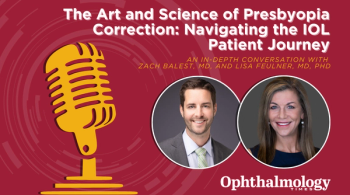
5 unique ways to optimize care for glaucoma patients
In assessing patients with glaucoma, ophthalmologists should look beyond the standard clinical metrics and consider how the disease may be impacting daily living.
Dr. BhoradeSt. Louis, MO-In assessing
According to glaucoma specialist, Anjali Bhorade, MD, the process begins by exploring problems that patients may be having with "5 Ds:" daily activities, driving, disability from falls, dual-sensory loss, and depression.
Depending on what they uncover, there are a variety of simple recommendations and referrals ophthalmologists can make that can have a major benefit for improving patient safety and quality of life, said Dr. Bhorade, associate professor of ophthalmology and visual sciences, Washington University, St. Louis, MO.
“As clinicians, we often discuss with patients the results from
Asking about difficulties with daily activities is important, as many glaucoma patients have trouble with such tasks as reading, writing, matching clothes, mobility, and self-care.
(Image courtesy of Anjali Bhorade, MD)
Increasing home lighting and informing patients about low-vision aids and services-such as books on tape and various mobile apps-may help address some problems. However, patients may also benefit from referral to a low-vision occupational therapist or a low-vision clinic for more individualized solutions.
Discussing dual-sensory loss, Dr. Bhorade said that hearing loss is a common, but underrecognized and undertreated problem in older patients.
“If you ask patients about their hearing and get no response, it is a good indicator for referring the patient to an audiologist for a hearing evaluation,” she jested.
Asking about driving is important as vision loss from glaucoma can compromise driver safety, but also because some glaucoma patients may be limiting their driving even though they can drive safely. To assess driver safety, ophthalmologists can refer patients for an on-road driving evaluation and then take further action based on the findings.
Patients who are deemed safe may still benefit from participating in a driving safety program or from conditional driving restriction. Patients identified as unsafe to drive can be referred to driving cessation programs that connect participants with support groups and alternative modes of transportation, Dr. Bhorade said.
She added that the American Medical Association has an excellent guide for physicians to help them assess and counsel older drivers.
Patients with glaucoma are also at increased risks for falls. In addition to asking about these events, ophthalmologists can look for clues, such as whether the patient has any bruises, casts, or braces.
Changing the patient’s glasses from bifocals or progressive correction lenses to separate distance and near glasses can enable greater safety in maneuvering down stairs. A visit to the home by an occupational therapist is also useful for identifying any environmental hazards that can increase risk for falls.
Patients may also benefit from referral to orientation and mobility specialists or physical therapists for training or assistive devices to improve their mobility.
Risk of depression has been shown to be increased in patients with glaucoma, and is higher as the level of visual field loss increases. Depression may also be more likely in patients who are having a problem with any of the other “5 Ds”. Aside from simply inquiring about depressive symptoms, ophthalmologists can administer a simple screening questionnaire, such as the Geriatric Depression Scale.
Patients who show signs and symptoms of depression should be referred to a mental health specialist, but can also be counseled about glaucoma support groups or the Glaucoma Service Foundation to Prevent Blindness online chat room.
Anjali Bhorade, MD
Dr. Bhorade has no relevant financial interests to disclose.
Newsletter
Don’t miss out—get Ophthalmology Times updates on the latest clinical advancements and expert interviews, straight to your inbox.


















































.png)


